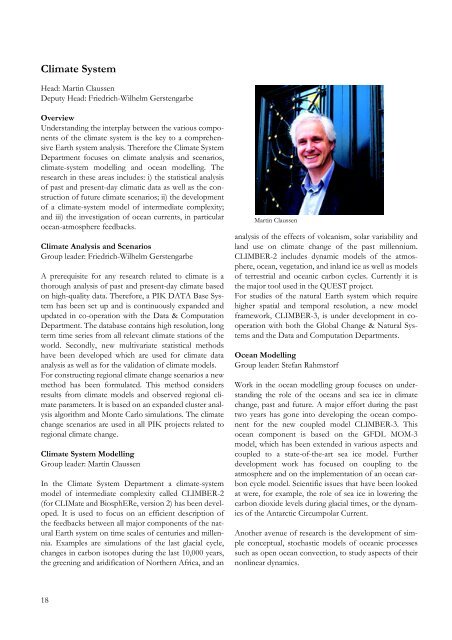PIK Biennial Report 2000-2001 - Potsdam Institute for Climate ...
PIK Biennial Report 2000-2001 - Potsdam Institute for Climate ...
PIK Biennial Report 2000-2001 - Potsdam Institute for Climate ...
Create successful ePaper yourself
Turn your PDF publications into a flip-book with our unique Google optimized e-Paper software.
<strong>Climate</strong> System<br />
Head: Martin Claussen<br />
Deputy Head: Friedrich-Wilhelm Gerstengarbe<br />
Overview<br />
Understanding the interplay between the various components<br />
of the climate system is the key to a comprehensive<br />
Earth system analysis. There<strong>for</strong>e the <strong>Climate</strong> System<br />
Department focuses on climate analysis and scenarios,<br />
climate-system modelling and ocean modelling. The<br />
research in these areas includes: i) the statistical analysis<br />
of past and present-day climatic data as well as the construction<br />
of future climate scenarios; ii) the development<br />
of a climate-system model of intermediate complexity;<br />
and iii) the investigation of ocean currents, in particular<br />
ocean-atmosphere feedbacks.<br />
<strong>Climate</strong> Analysis and Scenarios<br />
Group leader: Friedrich-Wilhelm Gerstengarbe<br />
A prerequisite <strong>for</strong> any research related to climate is a<br />
thorough analysis of past and present-day climate based<br />
on high-quality data. There<strong>for</strong>e, a <strong>PIK</strong> DATA Base System<br />
has been set up and is continuously expanded and<br />
updated in co-operation with the Data & Computation<br />
Department. The database contains high resolution, long<br />
term time series from all relevant climate stations of the<br />
world. Secondly, new multivariate statistical methods<br />
have been developed which are used <strong>for</strong> climate data<br />
analysis as well as <strong>for</strong> the validation of climate models.<br />
For constructing regional climate change scenarios a new<br />
method has been <strong>for</strong>mulated. This method considers<br />
results from climate models and observed regional climate<br />
parameters. It is based on an expanded cluster analysis<br />
algorithm and Monte Carlo simulations. The climate<br />
change scenarios are used in all <strong>PIK</strong> projects related to<br />
regional climate change.<br />
<strong>Climate</strong> System Modelling<br />
Group leader: Martin Claussen<br />
In the <strong>Climate</strong> System Department a climate-system<br />
model of intermediate complexity called CLIMBER-2<br />
(<strong>for</strong> CLIMate and BiosphERe, version 2) has been developed.<br />
It is used to focus on an efficient description of<br />
the feedbacks between all major components of the natural<br />
Earth system on time scales of centuries and millennia.<br />
Examples are simulations of the last glacial cycle,<br />
changes in carbon isotopes during the last 10,000 years,<br />
the greening and aridification of Northern Africa, and an<br />
18<br />
Martin Claussen<br />
analysis of the effects of volcanism, solar variability and<br />
land use on climate change of the past millennium.<br />
CLIMBER-2 includes dynamic models of the atmosphere,<br />
ocean, vegetation, and inland ice as well as models<br />
of terrestrial and oceanic carbon cycles. Currently it is<br />
the major tool used in the QUEST project.<br />
For studies of the natural Earth system which require<br />
higher spatial and temporal resolution, a new model<br />
framework, CLIMBER-3, is under development in cooperation<br />
with both the Global Change & Natural Systems<br />
and the Data and Computation Departments.<br />
Ocean Modelling<br />
Group leader: Stefan Rahmstorf<br />
Work in the ocean modelling group focuses on understanding<br />
the role of the oceans and sea ice in climate<br />
change, past and future. A major ef<strong>for</strong>t during the past<br />
two years has gone into developing the ocean component<br />
<strong>for</strong> the new coupled model CLIMBER-3. This<br />
ocean component is based on the GFDL MOM-3<br />
model, which has been extended in various aspects and<br />
coupled to a state-of-the-art sea ice model. Further<br />
development work has focused on coupling to the<br />
atmosphere and on the implementation of an ocean carbon<br />
cycle model. Scientific issues that have been looked<br />
at were, <strong>for</strong> example, the role of sea ice in lowering the<br />
carbon dioxide levels during glacial times, or the dynamics<br />
of the Antarctic Circumpolar Current.<br />
Another avenue of research is the development of simple<br />
conceptual, stochastic models of oceanic processes<br />
such as open ocean convection, to study aspects of their<br />
nonlinear dynamics.

















